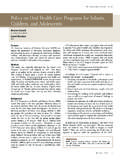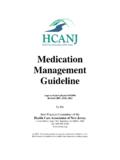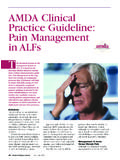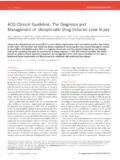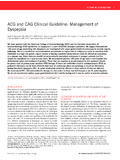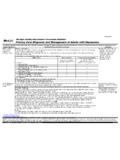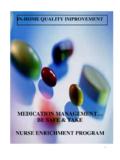Transcription of Guideline for Monitoring and Management of Pediatric ...
1 AMERICAN ACADEMY OF Pediatric DENTISTRYCLINICAL PRACTICE guidelines 211 AbstractThe safe sedation of children for procedures requires a system-atic approach that includes the following: no administration of sedating medication without the safety net of medical super- vision, careful presedation evaluation for underlying medical or surgical conditions that would place the child at increased risk from sedating medications, appropriate fasting for elective procedures and a balance between depth of sedation and risk for those who are unable to fast because of the urgent nature of the procedure, a focused airway examination for large tonsils or anatomic airway abnormalities that might increase the potential for airway obstruction.
2 A clear understanding of the pharmaco-kinetic and pharmacodynamic effects of the medications used for sedation as well as an appreciation for drug interactions, appropriate training and skills in airway Management to allow rescue of the patient, age- and size-appropriate equipment for airway Management and venous access, appropriate medica- tions and reversal agents, sufficient numbers of people to both carry out the procedure and monitor the patient, appropriate physiologic Monitoring during and after the procedure, a properly equipped and staffed recovery area, recovery to pre- sedation level of consciousness before discharge from medical supervision, and appropriate discharge instructions.
3 IntroductionInvasive diagnostic and minor surgical procedures on Pediatric patients outside the traditional operating room setting have increased in the last decade. As a consequence of this change and the increased awareness of the importance of providing analgesia and anxiolysis, the need for sedation for procedures in physician offices, dental offices, subspecialty procedure suites, imaging facilities, emergency departments, and ambulatory surgery centers also has markedly In recognition of this need for both elective and emergency use of sedation in nontraditional settings, the American Academy of Pediatrics (AAP) and American Academy of Pediatric Dentistry (AAPD)
4 Have published a series of guidelines for the Monitoring and Management of Pediatric patients during and after sedation for a The purpose of this updated statement is to unify the guidelines for sedation used by medical and dental practitioners, add clarifications regarding Monitoring modalities, provide new information from medical and dental literature, and suggest methods for further improvement in safety and outcomes. With the revision of this document, the Joint Commission on Accreditation of Healthcare Organiza- tions, the American Society of Anesthesiologists (ASA), the AAP, and the AAPD will use similar language to define sedation categories and the expected physiologic This revised statement reflects the current understanding of appropriate Monitoring needs both during and after seda- tion for a ,5,12,19,21,22,26,45-53 The Monitoring and care out-lined in this Guideline may be exceeded at any time, based on the judgment of the responsible practitioner.
5 Although in- tended to encourage high-quality patient care, adherence to this Guideline cannot guarantee a specific patient outcome. However, structured sedation protocols designed to incorporate the principles in this document have been widely implemented and shown to reduce ,32-34,37,54,55 This Guideline is proffered with the awareness that, regardless of the intended level of sedation or route of administration, the sedation of a Pediatric patient represents a continuum and may result in respiratory depression and the loss of the patient s protective ,57-60 Sedation of Pediatric patients has serious associated risks, such as hypoventilation, apnea, airway obstruction, laryngo-spasm, and cardiopulmonary ,6,22,45,46,54.
6 60-69 These adverse responses during and after sedation for a diagnostic or therapeutic procedure may be minimized, but not completely eliminated, by a careful preprocedure review of the patient s underlying medical conditions and consideration of how the sedation process might affect or be affected by these Appropriate drug selection for the intended procedure as well as the presence of an individual with the skills needed to rescue a patient from an adverse response are essential. Guideline for Monitoring and Management of Pediatric Patients During and After Sedation for Diagnostic and Therapeutic Procedures Developed and Endorsed by American Academy of Pediatrics and the American Academy of Pediatric DentistryAdopted 2006 Reaffirmed 2011212 CLINICAL PRACTICE guidelines REFERENCE MANUAL V 37 / NO 6 15 / 16 Appropriate physiologic Monitoring and continuous observa- tion by personnel not directly involved with the procedure allow for accurate and rapid diagnosis of complications and initiation of appropriate rescue ,51,54 The sedation of children is different from the sedation of adults.
7 Sedation in children often is administered to control behavior to allow the safe completion of a procedure. A child s ability to control his or her own behavior to cooperate for a procedure depends both on his or her chronologic and devel-opmental age. Often, children younger than six years and those with developmental delay require deep levels of sedation to gain control of their Therefore, the need for deep sedation should be anticipated. Children in this age group are particularly vulnerable to the sedating medication s effects on respiratory drive, patency of the airway, and protective Studies have shown that it is common for children to pass from the intended level of sedation to a deeper, unintended level of ,59,70 For older and cooperative children, other modalities, such as parental presence, hypnosis, distraction, topical local anesthetics, and guided imagery, may reduce the need for or the needed depth of pharmacologic ,71-81 The concept of rescue is essential to safe sedation.
8 Practitioners of sedation must have the skills to rescue the patient from a deeper level than that intended for the proce-dure. For example, if the intended level of sedation is minimal, practitioners must be able to rescue from moderate sedation ; if the intended level of sedation is moderate, practitioners must have the skills to rescue from deep sedation ; if the intended level of sedation is deep, practitioners must have the skills to rescue from a state of general anesthesia. The ability to rescue means that practitioners must be able to recognize the various levels of sedation and have the skills necessary to provide appropriate cardiopulmonary support if needed.
9 Sedation and anesthesia in a nonhospital environment (private physician or dental office or freestanding imaging facility) may be associated with an increased incidence of failure to rescue the patient should an adverse event occur, because the only backup in this venue may be to activate emergency medical services (EMS).46,82 Rescue therapies re- quire specific training and ,54,83,84 Maintenance of the skills needed to perform successful bag-valve-mask ventilation is essential to successfully rescue a child who has become apneic or developed airway obstruction. Familiarity with emergency airway Management procedure algorithms is Practitioners should have an in-depth knowledge of the agents they intend to use and their potential com- plications.
10 A number of reviews and hand-books for sedating Pediatric patients are ,48,55,88-93 This Guideline is intended for all venues in which sedation for a procedure might be performed (hospital, surgical center, freestanding imaging facility, dental facility, or private office). There are other guidelines for specific situations and personnel that are beyond the scope of this document. Specifically, guidelines for the delivery of general anesthesia and monitored anesthesia care (sedation or analgesia), outside or within the operating room by anesthesiologists or other practitioners functioning within a department of anesthesiol- ogy, are addressed by policies developed by the ASA and by individual departments of Also, guidelines for the sedation of patients undergoing mechanical ventilation in a critical care environment or for providing analgesia for patients postoperatively, patients with chronic painful condi- tions, and hospice care are beyond the scope of this of terms for this report Pediatric patients: all patients through 21 years of age, as defined by the AAP.





